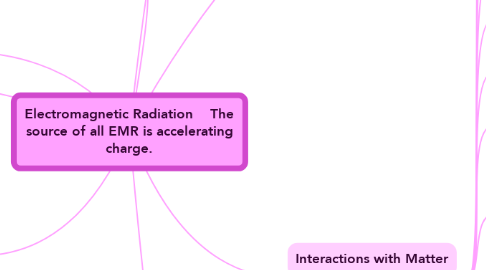Electromagnetic Radiation The source of all EMR is accelerating charge.
作者:Jessi Moe


1. Speed of Light
1.1. Light waves travel at a maximum speed of 300,000 km/s (186,000 mi/s).
2. Wavelength
2.1. The wavelengths of EMR can be as small as one billionth of a meter, gamma rays, but visible light wavelengths range from 400 to 700 billionths of a meter.
3. Energy
3.1. The amount of energy in a light wave is proportionally related to its frequency. In other words, the higher the frequency the more energy it contains; therefore, in the visible spectrum of visible light, violet has the most energy and red the least.
4. EMR Spectrum
4.1. The bands of the EMR spectrum are organized according to wavelength, frequency, and photon energy. Radio waves are the longest waves and are used in generating music radios. Microwaves are slightly shorter and are used in microwave ovens for heating. The visible spectrum of waves are even shorter and can be seen in the use of light bulbs. X-rays are some of the shortest waves and are used in X-ray machines.
5. Frequency
5.1. Frequency measures the number of waves that pass a given point per second (Hertz). The range of wave frequencies extends beyond the visible spectrum to include radio waves and gamma rays, but color demonstrates the frequency of visible light waves (430 trillion Hz-750 trillion Hz).
6. Propagation
6.1. EMR can travel both as a particle and as a wave.
7. Representations
7.1. Wave: A light wave consists of energy in the form of electric and magnetic fields, as a result, it is also referred to as electromagnetic radiation (EMR).
7.2. Ray: It is a narrow beam of light.
7.3. Particle: a particle of light is represented by a photon.
7.4. Wave Front: It is due to a static source of light and is spherical in shape.
7.5. Wave Packet: Einstein believed that light was made up of a stream of energy packets called photons.
8. Interactions with Matter
8.1. Reflection: The atoms in some materials contain many free electrons that can jump readily from one atom to another within the material. When these electrons absorb energy from an incoming light wave, they don't pass that energy on to other atoms. The energized electrons simply vibrate and then send the energy back out of the object as a light wave with the same frequency as the incoming wave. As a result of reflection, most metals appear shiny.
8.2. Refraction: When the incoming light wave matches the natural vibration frequency of the electrons in a material, refraction occurs. In other words, the light wave penetrates deeply into the material and causes the electrons to vibrate. The electrons then pass these vibrations on to other atoms in the material, causing the part of the wave inside the material to slow down, or bending of the light occurs. For example, diamonds are glittery because they significantly slow down the incoming light.
8.3. Dispersion: White light is separated according to the different wavelengths it contains.
8.4. Diffraction: It occurs when light waves are bent around small objects and spread out when passed through small openings.
8.5. Interference: This occurs when two light waves from different sources meet and result in amplification.
8.6. Polarization: Light is polarized when a beam of light is changed so that the waves are vibrating in the same direction. This occurs when a glare appears off an object.
8.7. Absorption: When the frequency of an incoming light wave is near the vibrational frequency of the electrons in a given material, the electrons will simply take in the energy of the light wave and begin vibrating. However, when the electrons are held tightly by the atoms of the material, the incoming light results in the atoms speeding up. As a result of increased rate of collisions, the object appears dark or opaque. For example, wood is opaque to visible light due to absorption.
8.8. Scattering: It occurs as the result of reflection off of a rough surface, for example, the Earth's surface. Incoming light waves are reflected at varying angles as a result of the uneven surface.
8.9. Transparent: Transparent objects allow light to pass through them without the occurence of scattering. For example, glass is transparent.
8.10. Translucent: These objects allow some light to pass through them, but the objects on the other side of the material is not seen clearly. For example, sunglass lenses are translucent.
8.11. Opaque: Opaque objects do not allow any light to pass through them. For example, a door is opaque.
8.12. Fluorescence: It is lighting that is caused by the absorption of radiation at one wavelength followed by an immediate reradiation at a different wavelength.
8.13. Phosphorescence: It is lighting that is caused by the absorption of radiations.
8.14. Color
8.14.1. Additive Model: By adding various combinations of red, green, and blue light, it is possible to make all the colors of the visible spectrum. For example, this is how computer monitors produce colors.
8.14.2. Subtractive Model: Some of the frequencies of light are absorbed and the white light combination is removed. The absorbed colors are the only ones that the eye sees. For example, this is how colored paints are made.
8.14.3. Physical Light
8.14.4. Physiological Light
